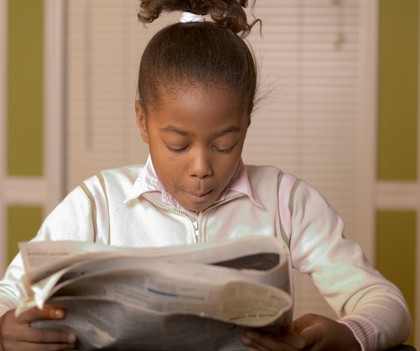“A lie can travel halfway around the world while the truth is still putting on its shoes.” –Mark Twain (but not really).[1]
Thanks to the Internet, news can travel around the world at the speed of light. So can lies, conspiracy theories, and misinformation. The spread of wild conspiracy theories online is more than just confusing, as evidenced by trying to figure out who really said that ‘Mark Twain’ quote; it can even lead to violence and real-world harm.
While some look to technology regulations to combat the scourge of fake news, the strongest defense may well be in building a citizenry with strong media literacy skills.[2] Read on to learn how we got here, why it matters, and how teachers can build media literacy in the classroom.
Media Literacy: Why It’s Critical Now More Than Ever
Media literacy’s simplest definition is “the ability to access, analyze, evaluate, and create media in a variety of forms.”[3] But the real-life challenges of media literacy go beyond that. 
A functioning democracy depends on an informed public. The good news is that information is easier to come by than ever before—many students, even at an elementary age, have access to smartphones, the Internet, and a pervasive, never-ending flow of social media. But the big question is: of what quality is that information?
Within the past generation, the news ecosystem was well-established. Cities and even the smallest of towns had newspapers delivering local information, from zoning boards to youth sports up to national happenings, right to people’s front steps. Meanwhile, state, national, and world news organizations were the primary sources of information.
But with the rise of the Internet, that ecosystem grew unstable. Digital advertising revenues for news operations increased slightly, but print ad revenue crashed. In the past 15 years, more than 1 in 5 newspapers in America has closed. The number of journalists working for papers has been cut in half.[4]
This has created “News Deserts” across America. Now, more than 65 million Americans live in counties with only one local newspaper, or none at all.[5]
Today, social media plays an outsized role in how people get their information. In 2020, about 1 in 5 American adults said they got their political news primarily through social media.[6] In this landscape, unfounded conspiracy theories, outright false news, or shoddy third-hand accounts can spread just as easily as a legitimately reported story. Sometimes easier.
That’s why it’s critical to teach children how to think critically about the media they consume and how to evaluate their sources of information.
The Benefits of Media Literacy
Teaching media literacy to students will benefit them as they grow. According to Fresno Pacific University, “Media literacy helps students become wiser consumers of media as well as responsible producers of their own media. Along those same lines, teaching media literacy helps to foster critical thinking in students. This type of thinking can eventually become second nature, which will help them in many areas as they grow older.”[12]
 Working on media and news literacy in class can help students become stronger critical thinkers in all aspects of their lives. This becomes especially important when we realize that elementary and teen-aged students are already swimming in the digital ecosystem. In 2018, the Pew Research Center found that 97% of 13- to 17-year-olds surveyed used social media, while about 45% were online almost constantly.[11]
Working on media and news literacy in class can help students become stronger critical thinkers in all aspects of their lives. This becomes especially important when we realize that elementary and teen-aged students are already swimming in the digital ecosystem. In 2018, the Pew Research Center found that 97% of 13- to 17-year-olds surveyed used social media, while about 45% were online almost constantly.[11]
How Teens Can Combat Misinformation on Social Media
Addressing social media misinformation is one way to empower children to fight back against fake news. Here are some online resources devoted to social media misinformation.
Take a News Literacy Quiz
This online quiz lets teens test whether or not they can evaluate what should be shared on social media. The user can choose to see a news feed aimed at conservatives or liberals, and try to determine whether a post has enough verified information to share.
Learn Why Your News Feed Sucks
This 12-minute video from Smarter Every Day[9] is appropriate for middle- to high-school-aged students. It does an elegant job of pointing out why social media news feeds are terrible for gathering unbiased, accurate news. Students can learn how to determine if a post in their social media feed is “share-worthy” as presenters track down the accuracy of a viral photograph with tools and information students can use themselves.
Sanitize Before Your Share
“Sanitize Before You Share” uses something all students are familiar with—like using good hygiene—and relates that to using good information hygiene to stop the spread of fake news. This project is suitable for elementary through high school students.
More Online Resources for Teaching Media Literacy Skills in the Classroom
In addition to the above resources, there are plenty of quality online activities and curriculum for combating misinformation and teaching media literacy.
NewseumED’s Media Literacy Booster Pack
The Media Literacy Booster Pack is a free resource and a good starting point for teaching media literacy to grade 6-12 students.[7] Free exercises and activities include evaluating information, recognizing bias, and filtering out fake news, along with several other important media and digital literacy skills.
National Association for Media Literacy Education
NAMLE’s website includes resources for the classroom, as well as for parents and families at home. Particularly useful is their material dedicated to teaching how to spot and fight misinformation.
Media Literacy Week
The website dedicated to Media Literacy Week has resources for classrooms ranging from elementary school to high school and higher-education level.
InfoZones
The News Literacy Project has educator resources for use in elementary through high school. Resources include “InfoZones,” which helps students understand not all information is equal, and credibility is often correlated with purpose.
Students will learn to categorize information by its purpose, and how to use that to determine the credibility.
Challenging Confirmation Bias
Confirmation Bias is when our brain looks for information that confirms what we already think we know.[8] It’s one reason people are more likely to share news that confirms what they already think. Common Sense Education offers an activity for helping high school students understand confirmation bias, why it occurs, and how to confront their own biases.
Stanford’s Civic Online Reasoning
Stanford University hosts the Civic Online Reasoning website, dedicated to helping students evaluate online information. The COR curriculum is available for free online, and it includes skills such as Teaching Lateral Reading—helping students go beyond what’s posted online by seeing what other information is available about the source. Other topics include how to find better sources of online information, “click restraint,” and more.
Make Your Own News With These Student Journalism Ideas
Taking a hands-on approach is one way to help students see what’s necessary for a news source to be reliable and fact-based. Helping your students produce their own newspaper or website can give them the tools needed to be a responsible information consumer.
From the Newsroom to the Classroom
Why not get the scoop straight from a real journalist? The News Literacy Project coordinates with educators to bring journalists into middle or high school classrooms to share what they do in their job. The program allows students to hear from actual reporters and enhance their media literacy.
Find Resources for Starting a Student Newspaper
Student newspapers can be in-class bulletins, website posts, or near-professional printed papers. Once permission is secured and an adviser selected, involve students in producing the newspaper by finding writers, editors, photographers, and multimedia specialists, as well as other roles. By working in these roles, students can develop a sense of what goes into the production of a responsible, fact-based news story.
Depending on the product (web, print, or both), setup can take some time, effort, and money. For more reading on what educators should know about launching a newspaper, visit the American Press Institute’s Student Journalism Resources.
Sources:
- Chokshi, Niraj. “That Wasn’t Mark Twain: How a Misquotation Is Born.” New York Times. April 26, 2017. https://www.nytimes.com/2017/04/26/books/famous-misquotations.html
- Hobbs, Renee. “Building Citizenship Skills Through Media Literacy Education.” Center for Media LIteracy. 1998. http://www.medialit.org/reading-room/building-citizenship-skills-through-media-literacy-education
- Center for Media Literacy. “Media Literacy: A Definition and More.” https://www.medialit.org/media-literacy-definition-and-more
- University of North Carolina Hussman School of Journalism and Media. “The Loss of Local News: What It Means for Communities.” USNewsdeserts.com. https://www.usnewsdeserts.com/reports/expanding-news-desert/loss-of-local-news/
- Hendrickson, Clara. “Local Journalism in Crisis: Why America Must Revive Its Local Newsrooms.” Brookings. Nov. 12, 2019. https://www.brookings.edu/research/local-journalism-in-crisis-why-america-must-revive-its-local-newsrooms/
- Mitchell, Amy, Mark Jurkowitz, J. Baxter Oliphant, and Elisa Shearer. “Americans Who Mainly Get Their News on Social Media Are Less Engaged, Less Knowledgeable.” Pew Research Center on Journalism & Media. July 30, 2020. https://www.journalism.org/2020/07/30/americans-who-mainly-get-their-news-on-social-media-are-less-engaged-less-knowledgeable/
- Newseumed.org. “Filtering Out Fake News.” https://newseumed.org/curated-stack/filtering-out-fake-news
- Common Sense Education. “Challenging Confirmation Bias.” https://www.commonsense.org/education/digital-citizenship/lesson/challenging-confirmation-bias
- Smarter Every Day. “Why Your Newsfeed Sucks.” https://youtu.be/MUiYglgGbos
- Common Sense Education. “Help Your Students Fact-Check the Web Like Professionals.” https://www.commonsense.org/education/videos/help-your-students-fact-check-the-web-like-professionals
- Mayo Clinic. “Teens and Social Media Use: What’s the Impact?” Tween and Teen Health. December 2019. https://www.mayoclinic.org/healthy-lifestyle/tween-and-teen-health/in-depth/teens-and-social-media-use/art-20474437
- Fresno Pacific University. “Why Today’s Students Need Media Literacy More Than Ever.” December 2018. https://ce.fresno.edu/news/why-todays-students-need-media-literacy-more-than-ever

